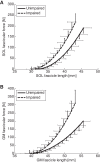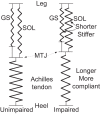Concurrent deficits of soleus and gastrocnemius muscle fascicles and Achilles tendon post stroke
- PMID: 25663670
- PMCID: PMC4385882
- DOI: 10.1152/japplphysiol.00226.2014
Concurrent deficits of soleus and gastrocnemius muscle fascicles and Achilles tendon post stroke
Abstract
Calf muscles and Achilles tendon play important roles in functional activities. However, it is not clear how biomechanical properties of the uniarticular soleus (SOL) and biarticular gastrocnemius muscle and Achilles tendon, including the fascicle length, pennation angle, and stiffness, change concurrently post stroke. Biomechanical properties of the medial gastrocnemius (GM) and soleus muscles were evaluated bilaterally in 10 hemiparetic stroke survivors using combined ultrasonography-biomechanical measurements. Biomechanical properties of the Achilles tendon including the length, cross-sectional area (CSA), stiffness, and Young's modulus were evaluated, together with calf muscle biomechanical properties. Gastrocnemius and SOL contributions were separated using flexed and extended knee positions. The impaired side showed decreased fascicle length (GM: 6%, P = 0.002 and SOL: 9%, P = 0.03, at full knee extension and 0° ankle dorsiflexion) and increased fascicular stiffness (GM: 64%, P = 0.005 and SOL: 19%, P = 0.012, at a common 50 N force level). In contrast, Achilles tendon on the impaired side showed changes in the opposite direction as the muscle fascicles with increased tendon length (5%, P < 0.001), decreased tendon CSA (5%, P = 0.04), decreased tendon stiffness (42%, P < 0.001) and Young's modulus (30%, P < 0.001) compared with the unimpaired side. The fascicle and tendon stiffness changes were correlated negatively to the corresponding fascicle and tendon length changes, and decrease in Achilles tendon stiffness was correlated to the increases of SOL and GM fascicular stiffness (P < 0.05). Characterizations of calf muscle fascicles and Achilles tendon biomechanical properties help us better understand concurrent changes of fascicles and tendon as part of the calf muscle-tendon unit and facilitate development of more effective treatments.
Keywords: muscle fascicles; stiffness; stroke; tendon.
Copyright © 2015 the American Physiological Society.
Figures






Similar articles
-
Changes of calf muscle-tendon biomechanical properties induced by passive-stretching and active-movement training in children with cerebral palsy.J Appl Physiol (1985). 2011 Aug;111(2):435-42. doi: 10.1152/japplphysiol.01361.2010. Epub 2011 May 19. J Appl Physiol (1985). 2011. PMID: 21596920 Free PMC article.
-
Ultrasonic evaluations of Achilles tendon mechanical properties poststroke.J Appl Physiol (1985). 2009 Mar;106(3):843-9. doi: 10.1152/japplphysiol.91212.2008. Epub 2008 Dec 31. J Appl Physiol (1985). 2009. PMID: 19118156 Free PMC article.
-
In vivo evaluations of morphologic changes of gastrocnemius muscle fascicles and achilles tendon in children with cerebral palsy.Am J Phys Med Rehabil. 2011 May;90(5):364-71. doi: 10.1097/PHM.0b013e318214f699. Am J Phys Med Rehabil. 2011. PMID: 21765255
-
Towards modern understanding of the Achilles tendon properties in human movement research.J Biomech. 2023 May;152:111583. doi: 10.1016/j.jbiomech.2023.111583. Epub 2023 Apr 13. J Biomech. 2023. PMID: 37086579 Review.
-
Imaging and simulation of Achilles tendon dynamics: Implications for walking performance in the elderly.J Biomech. 2016 Jun 14;49(9):1403-1410. doi: 10.1016/j.jbiomech.2016.04.032. Epub 2016 May 3. J Biomech. 2016. PMID: 27209552 Free PMC article. Review.
Cited by
-
Does spastic myopathy determine active movement and ambulation speed in chronic spastic paresis?-A cross-sectional study on plantar flexors.PLoS One. 2024 Oct 24;19(10):e0310969. doi: 10.1371/journal.pone.0310969. eCollection 2024. PLoS One. 2024. PMID: 39446866 Free PMC article.
-
Immediate Effect of Whole Body Vibration on Knee Extensor Tendon Stiffness in Hemiparetic Stroke Patients.Medicina (Kaunas). 2021 Sep 29;57(10):1037. doi: 10.3390/medicina57101037. Medicina (Kaunas). 2021. PMID: 34684074 Free PMC article.
-
Alterations in Muscle Architecture: A Review of the Relevance to Individuals After Limb Salvage Surgery for Bone Sarcoma.Front Pediatr. 2020 Jun 16;8:292. doi: 10.3389/fped.2020.00292. eCollection 2020. Front Pediatr. 2020. PMID: 32612962 Free PMC article.
-
Changes in muscle-tendon unit length-force characteristics following experimentally induced photothrombotic stroke cannot be explained by changes in muscle belly structure.Eur J Appl Physiol. 2021 Sep;121(9):2509-2519. doi: 10.1007/s00421-021-04729-x. Epub 2021 Jun 1. Eur J Appl Physiol. 2021. PMID: 34061247 Free PMC article.
-
Do Muscle Changes Contribute to the Neurological Disorder in Spastic Paresis?Front Neurol. 2022 Mar 14;13:817229. doi: 10.3389/fneur.2022.817229. eCollection 2022. Front Neurol. 2022. PMID: 35370894 Free PMC article.
References
-
- Benard MR, Becher JG, Harlaar J, Huijing PA, Jaspers RT. Anatomical information is needed in ultrasound imaging of muscle to avoid potentially substantial errors in measurement of muscle geometry. Muscle Nerve 39: 652–665, 2009. - PubMed
-
- Bohannon RW, Smith MB. Interrater reliability of modified Ashworth scale of muscle spasticity. Phys Ther 67: 206–207, 1987. - PubMed
-
- Bojsen-Moller J, Kalliokoski KK, Seppanen M, Kjaer M, Magnusson SP. Low-intensity tensile loading increases intratendinous glucose uptake in the Achilles tendon. J Appl Physiol 101: 196–201, 2006. - PubMed
-
- Christensen B, Dyrberg E, Aagaard P, Enehjelm S, Krogsgaard M, Kjaer M, Langberg H. Effects of long-term immobilization and recovery on human triceps surae and collagen turnover in the Achilles tendon in patients with healing ankle fracture. J Appl Physiol 105: 420–426, 2008. - PubMed
-
- Chung SG, Van Rey E, Bai Z, Roth EJ, Zhang LQ. Biomechanic changes in passive properties of hemiplegic ankles with spastic hypertonia. Arch Phys Med Rehabil 85: 1638–1646, 2004. - PubMed
Publication types
MeSH terms
Grants and funding
LinkOut - more resources
Full Text Sources
Other Literature Sources
Medical

